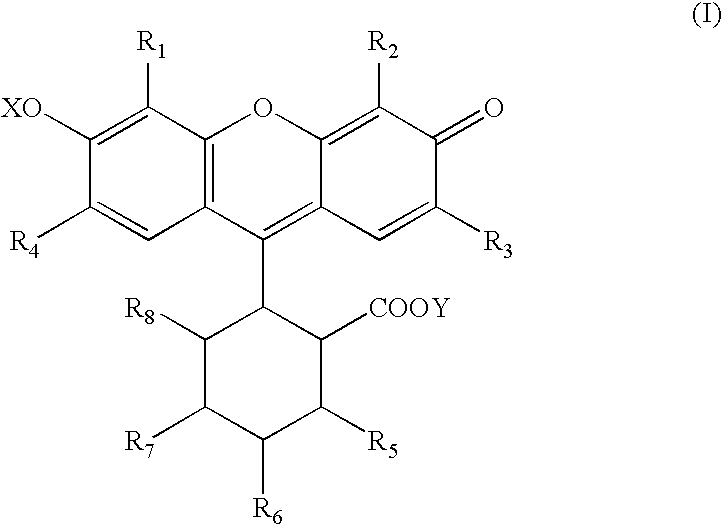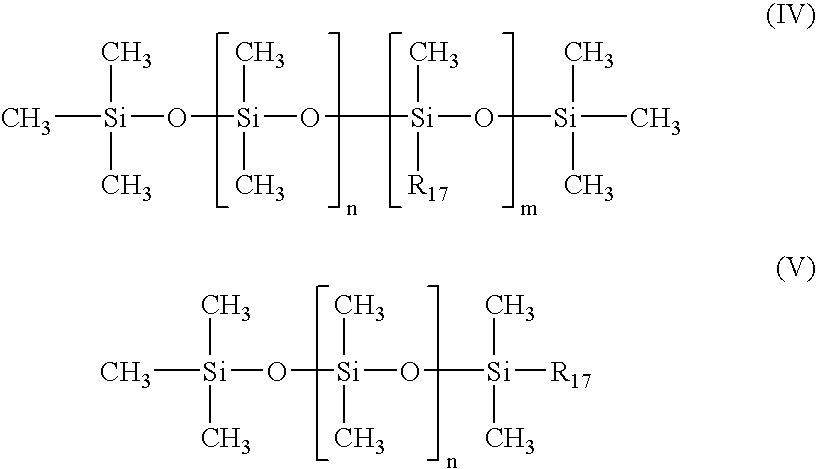Imaging compositions and methods
a composition and composition technology, applied in the field of compositions and methods, can solve the problems of no means suitable for use demanding real time processing, screen printing also meets with difficulty in obtaining fine patterns with precision, and cannot achieve the effect of stabilizing the color or shade change, rapid and efficient, and slowing down the tedious process of applying marks
- Summary
- Abstract
- Description
- Claims
- Application Information
AI Technical Summary
Benefits of technology
Problems solved by technology
Method used
Image
Examples
example 1
Phototropic Imaging Composition
[0099]The phototropic imaging composition with components disclosed in the table below are prepared at room temperature under red light.
[0100]
TABLE 1ComponentPercent WeightFilm forming acrylic polymer25Calcium carbonate20o-chloro-hexaarylbiimidazole62′,4′, 5′,7′-tetrabromo-0.53,4,5,6-tetrachlorofluoresceindisodium salt2,2-methylene-bis(4-methyl-6-0.5tertbutylphenol)Leuco Crystal Violet1Polyalky betaine polysiloxane copolymer2Ethylene glycol phenyl ether10Water35
[0101]The acrylic polymer is a latex polymer which may be prepared by known methods in the art, or may be obtained commercially from Rohm and Haas Company of Philidelphia, Pa. under the tradename RHOPLEX™ E-1801. The polyalkyl betaine polysiloxane copolymer is mixed with the acrylic polymer in water to form an aqueous suspension. Calcium carbonate is added to the aqueous suspension to provide a pH of from 8 to 11.
[0102]Leuco crystal violet, O-chloro-hexaarylbiimidazole, 2′,4′,5′,7′-tetrabromo-3,...
example 2
Photofugitive Composition
[0107]The components listed in the table below are combined to at room temperature under red light to form a photofugitive imaging composition.
[0108]
TABLE 2ComponentsWeight PercentCopolymer of styrene and acrylic acid25Calcium carbonate20Cyclopentanone-2,5-bis [[4-0.5(diethylamino)phenyl]methylene]-Leuco Crystal Violet1o-chloro-hexaarylbiimidazole6.51,2-naphthoquinone0.5Triethanolamine triacetate1.5Polyalkyl betaine polysiloxane copolymer2Ester alcohol8Water35
[0109]Copolymers of styrene and acrylic acid are known and methods for preparing them may be found in the literature. They are also commercially available such as under the tradename RHOPLEX™ P-376, which is obtainable from Rohm and Haas Company. The copolymer is mixed in water with the polyalkyl betaine polysiloxane copolymer to form an aqueous suspension. Calcium carbonate is added to the suspension to maintain a pH of 8 to 11.
[0110]The imaging components: leuco crystal violet, o-chloro-hexaarylbiimid...
example 3
Phototropic Composition
[0114]The following composition is prepared at room temperature under red light.
[0115]
TABLE 3ComponentWeight PercentVinyl acetate / acrylic copolymer emulsion252-alkyl-2-imidazoline15Vinyl aromatic polymer5Leuco Crystal Violet1Tribromo methyl phenyl sulfone6.52′,4′, 5′, 7′-tetraiodo-0.53,4,5,6-tetrachlorofluoresceindisodium salt2,2′-methylene-bis(4-methyl-26-tertbutylphenol)Ethylene glycol phenyl ether10Water35
[0116]The vinyl acetate / acrylic copolymer is known in the art and methods of preparing it are well known. Such copolymers also are commercially available under the trade-name ROVACE™ 661, which is obtainable from Rohm and Haas Company. The copolymer, vinyl aromatic polymer, and the 2-alky-2-imidazoline are mixed in water to form an aqueous emulsion.
[0117]The imaging components: leuco crystal violet, tribromo methyl phenyl sulfone, 2′,4′,5′,7′-tetraiodo-3,4,5,6-tetrachlorofluorescein disodium salt, and micro-encapsulated 2,2′-methylene-bis(4-methyl-6-tertbu...
PUM
| Property | Measurement | Unit |
|---|---|---|
| isoelectric point | aaaaa | aaaaa |
| isoelectric point | aaaaa | aaaaa |
| Tg | aaaaa | aaaaa |
Abstract
Description
Claims
Application Information
 Login to View More
Login to View More - R&D
- Intellectual Property
- Life Sciences
- Materials
- Tech Scout
- Unparalleled Data Quality
- Higher Quality Content
- 60% Fewer Hallucinations
Browse by: Latest US Patents, China's latest patents, Technical Efficacy Thesaurus, Application Domain, Technology Topic, Popular Technical Reports.
© 2025 PatSnap. All rights reserved.Legal|Privacy policy|Modern Slavery Act Transparency Statement|Sitemap|About US| Contact US: help@patsnap.com



